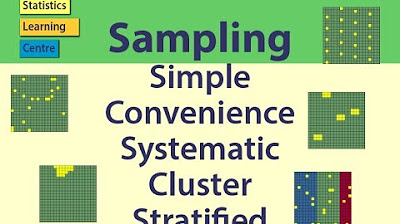Tutorial 2- What is Population And Sample And Sampling Techniques In Hindi?
TLDRThe video script discusses various sampling techniques and their applications in understanding population dynamics. It delves into simple random sampling, stratified sampling, systematic sampling, and cluster sampling, explaining their significance and how they can be effectively utilized to gather representative data. The importance of accurate data in decision-making processes, such as exit polls and understanding public opinion, is highlighted. The script also touches on the challenges of capturing the entire population's views and the necessity of using sampling as a practical solution.
Takeaways
- 🎯 The video discusses various sampling techniques and their applications in understanding population dynamics.
- 🔍 The speaker emphasizes the importance of understanding the concept of population and sampling in order to gather critical information.
- 📊 The script introduces different types of sampling methods, such as simple random sampling, stratified sampling, systematic sampling, and cluster sampling.
- 🤝 The video highlights the significance of representative sampling to accurately reflect the opinions or characteristics of the entire population.
- 🗣️ The speaker explains the process of conducting surveys and polls, and how media outlets use sampling techniques to predict election outcomes.
- 📝 The importance of having a well-defined sampling frame and the challenges associated with capturing the entire population are discussed.
- 🔢 The script touches on the mathematical aspect of sampling, including the concept of margin of error and how it affects the reliability of the results.
- 🌐 The video provides an example of how to apply sampling techniques in a real-world scenario, such as conducting a survey in a specific region.
- 📈 The speaker discusses the use of systematic sampling in situations where it is impractical to survey every individual, such as in large populations.
- 🔄 The concept of overlapping and non-overlapping groups in sampling is explained, emphasizing the need for clear distinctions.
- 📚 The video serves as a tutorial for understanding sampling techniques and their relevance in data analysis and public opinion research.
Q & A
What is the main topic of discussion in the video?
-The main topic of discussion in the video is about sampling techniques and their application in understanding population dynamics and election polls.
What does the speaker mean by 'population' in the context of the video?
-In the context of the video, 'population' refers to the specific group of people or units of analysis that are being studied or surveyed, such as voters in an election.
What is the significance of 'interest in population' as mentioned in the script?
-The phrase 'interest in population' refers to the importance of understanding the characteristics and behaviors of a particular group of people, which is crucial for making informed decisions or predictions, such as in political polling.
How does the speaker define 'sampling' in the video?
-The speaker defines 'sampling' as the process of selecting a subset of individuals from a larger population for the purpose of study, with the goal of inferring information about the entire population based on the sample.
What are the key elements of a 'representative sample' as discussed in the video?
-A 'representative sample' should accurately reflect the larger population in terms of key characteristics, ensuring that the results obtained from the sample can be generalized to the entire population.
What is 'stratified sampling' and how is it used in the video context?
-Stratified sampling is a method where the population is divided into subgroups (strata) based on certain characteristics, and samples are taken from each subgroup to ensure that these characteristics are proportionally represented in the overall sample.
How does the speaker describe 'random sampling' and its importance?
-The speaker describes 'random sampling' as a method where individuals are chosen completely by chance, without any bias or pre-determined criteria. This method is important because it helps ensure that every member of the population has an equal chance of being included in the sample, which can lead to more accurate and unbiased results.
What is the significance of 'systematic sampling' mentioned in the script?
-Systematic sampling is a method where individuals are selected from the population according to a fixed, periodic interval. This method is used when the population is large and access to individuals is sequential, such as in a list or database.
What does the speaker imply about the limitations of exit polls?
-The speaker implies that exit polls, which survey people immediately after they have voted, are not always accurate in predicting election outcomes. This is because they may not capture the full diversity of voters and can be influenced by non-representative samples.
How does the speaker suggest using 'voluntary response sampling' in the context of data science?
-The speaker suggests that voluntary response sampling can be used in data science to gather information from a specific group, such as experts in a field, by asking them to participate in a survey or provide their insights on a particular topic.
What advice does the speaker give on choosing the right sampling technique?
-The speaker advises choosing the right sampling technique based on the specific needs and characteristics of the population being studied. It's important to consider factors such as the size of the population, the diversity of the group, and the resources available for the study.
Outlines
📚 Introduction to Sampling Techniques and Population
The paragraph introduces the concept of sampling techniques and their importance in understanding a population. It explains that sampling is a method used to gather information about a group without the need to survey every individual. The speaker discusses various types of sampling, such as simple random sampling, stratified sampling, and systematic sampling, emphasizing the need to choose the right technique based on the specific requirements of the study. The paragraph also touches on the challenges of capturing the entire population's views and the importance of representative sampling to ensure accurate results.
🔢 Understanding Different Sampling Techniques
This paragraph delves deeper into the different sampling techniques, explaining their applications and significance. It discusses simple random sampling, where every member of the population has an equal chance of being selected, and stratified sampling, which involves dividing the population into subgroups and sampling each group. The speaker also mentions systematic sampling, where samples are selected at regular intervals, and the importance of ensuring that the sampling method chosen is representative of the entire population. The paragraph highlights the need for a proper understanding of these techniques to accurately interpret data and make informed decisions.
📈 Systematic Sampling and Its Application
The paragraph focuses on systematic sampling, a method where samples are chosen according to a fixed pattern or interval. The speaker provides an example of conducting a survey in a mall, where every nth individual is selected for the study. This technique is useful when dealing with large populations and can be more efficient than simple random sampling. However, it's important to ensure that the starting point is random to avoid bias. The speaker emphasizes the critical nature of systematic sampling and how it can be used to gather information effectively while maintaining the representativeness of the sample.
📊 Volunteer Response Sampling and Household Expenses
In this paragraph, the speaker discusses volunteer response sampling, where individuals choose to participate in a survey or study. The focus is on understanding household expenses, and the speaker provides an example of a survey aimed at gathering information on this topic. The paragraph highlights the importance of considering the representativeness of the sample and the potential biases that may arise from volunteer respondents. It also touches on the need to ask specific questions that can provide valuable insights into household spending habits and other related financial aspects.
Mindmap
Keywords
💡Sampling
💡Population
💡Interest
💡Defining
💡Data
💡Technique
💡Media
💡Election
💡Random
💡Response
💡Average
Highlights
The introduction of the YouTube channel 'Krishna and Welcome To' and the topic of discussion on sampling techniques and their importance in data analysis.
The critical basic information that everyone should know about data unlimited scientist and the need for understanding sampling techniques.
The definition of population in the context of sampling, emphasizing its simplicity and the need to analyze data about a specific group.
The explanation of the term 'interested in standing' and its relevance to the analysis of data and understanding the group of interest.
The concept of 'Thrееее' and its role in sampling, including the definition and its significance in understanding the maximum population.
The discussion on the application of sampling in the context of an election, highlighting the practical use of sampling techniques in real-world scenarios.
The importance of media in elections and how they use sampling techniques to predict outcomes, emphasizing the limitations and challenges of this approach.
The definition and explanation of 'exit poll' and its comparison with 'exit poll', discussing the reactions and qualifications involved.
The concept of 'qualifying' in the context of sampling, explaining its role in selecting the right sample for analysis.
The introduction of different types of sampling techniques, providing insight into the various methods available for data analysis.
The explanation of 'stratified sampling' and its significance in dividing the population into layers for better analysis.
The concept of 'systematic sampling' and its use in surveys, discussing the method and its importance in achieving representative samples.
The discussion on 'voluntary response sampling' and its importance in understanding the family of convenience and the need for diverse responses.
The emphasis on the importance of sampling in data science and how it can be used to gain insights into various topics, such as household expenses.
The conclusion of the tutorial, summarizing the key points discussed and encouraging viewers to like, share, and subscribe for more informative content.
Transcripts
Browse More Related Video

Sampling: Simple Random, Convenience, systematic, cluster, stratified - Statistics Help

Probability and Non-Probability Sampling in Research Methods

Statistics Lecture 1.5: Sampling Techniques. How to Develop a Random Sample

What Are The Types Of Sampling Techniques In Statistics - Random, Stratified, Cluster, Systematic

4.2 Probability Sampling Techniques

Sampling: Sampling & its Types | Simple Random, Convenience, Systematic, Cluster, Stratified
5.0 / 5 (0 votes)
Thanks for rating: